Comprehensive Reflective Report: Design Thinking Workshop Analysis
VerifiedAdded on 2023/06/04
|11
|3565
|114
Report
AI Summary
This report reflects on a student's experience in a Design Thinking workshop, detailing the learning journey over a six-month period. The student explores various aspects of design thinking, including innovation, entrepreneurship, and problem-solving methodologies. The report covers key workshop activities, such as group discussions, problem analysis, and prototype development. It highlights the impact of design thinking on the student's perspective, emphasizing its role in fostering creativity, critical thinking, and the ability to translate ideas into practical solutions. The report also discusses the application of design thinking tools, such as journey mapping and value chain analysis, and their relevance in business and personal development. Furthermore, the student reflects on the importance of ethics, prototyping, and the 'learning launch' concept, concluding with an analysis of personal growth and the development of an action plan for future application of design thinking principles.
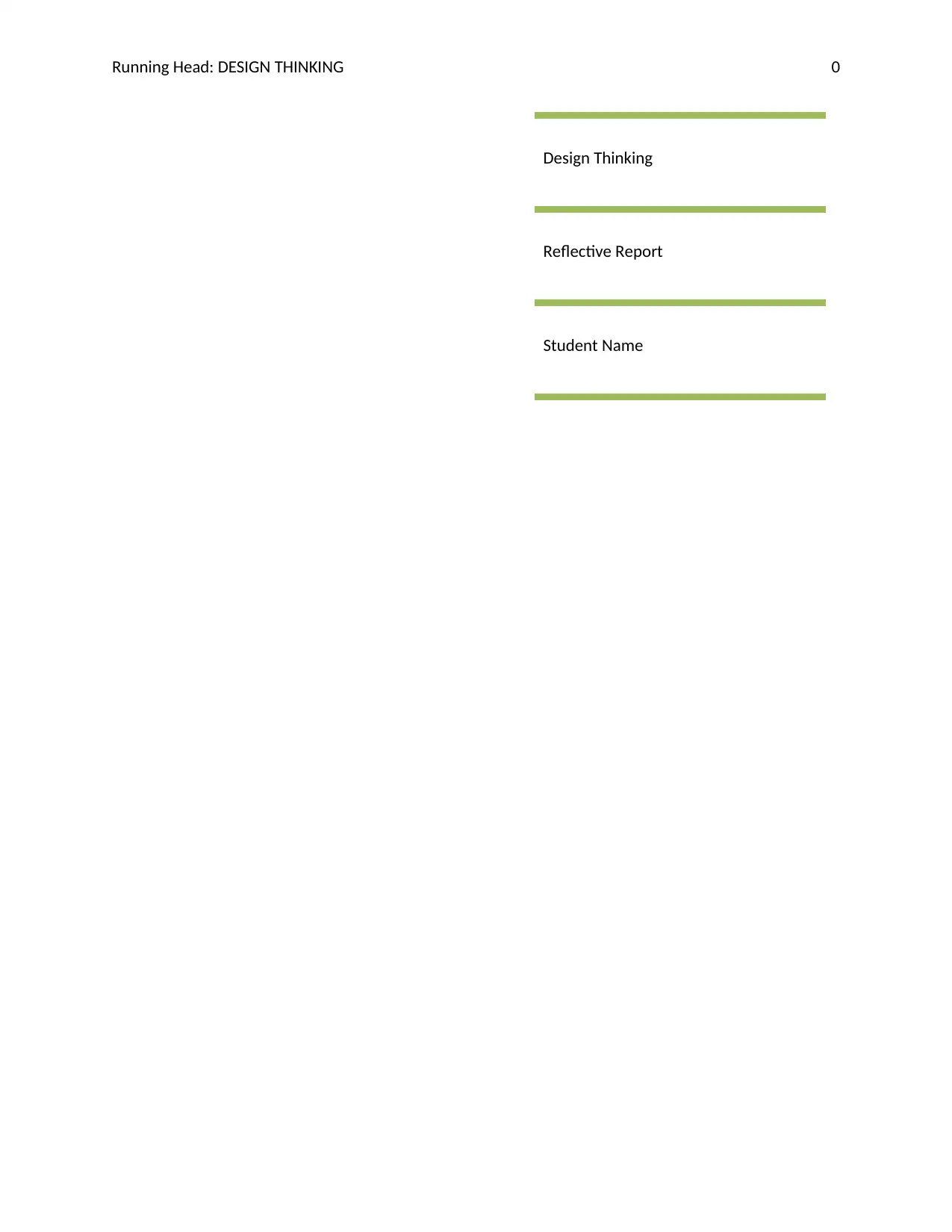
Running Head: DESIGN THINKING 0
Design Thinking
Reflective Report
Student Name
Design Thinking
Reflective Report
Student Name
Paraphrase This Document
Need a fresh take? Get an instant paraphrase of this document with our AI Paraphraser

Design Thinking 1
Table of Contents
Design Thinking..............................................................................................................................1
Bibliography....................................................................................................................................7
Table of Contents
Design Thinking..............................................................................................................................1
Bibliography....................................................................................................................................7
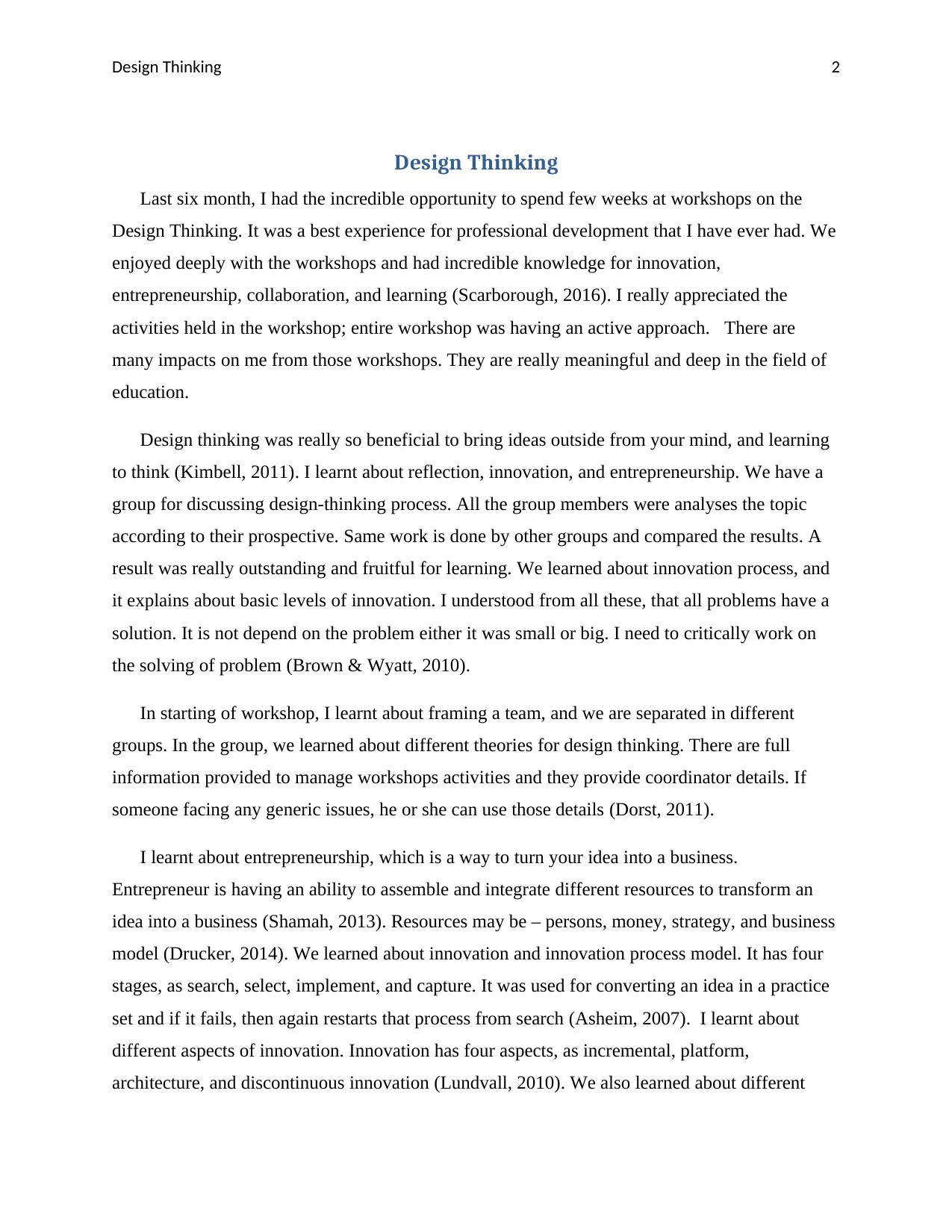
Design Thinking 2
Design Thinking
Last six month, I had the incredible opportunity to spend few weeks at workshops on the
Design Thinking. It was a best experience for professional development that I have ever had. We
enjoyed deeply with the workshops and had incredible knowledge for innovation,
entrepreneurship, collaboration, and learning (Scarborough, 2016). I really appreciated the
activities held in the workshop; entire workshop was having an active approach. There are
many impacts on me from those workshops. They are really meaningful and deep in the field of
education.
Design thinking was really so beneficial to bring ideas outside from your mind, and learning
to think (Kimbell, 2011). I learnt about reflection, innovation, and entrepreneurship. We have a
group for discussing design-thinking process. All the group members were analyses the topic
according to their prospective. Same work is done by other groups and compared the results. A
result was really outstanding and fruitful for learning. We learned about innovation process, and
it explains about basic levels of innovation. I understood from all these, that all problems have a
solution. It is not depend on the problem either it was small or big. I need to critically work on
the solving of problem (Brown & Wyatt, 2010).
In starting of workshop, I learnt about framing a team, and we are separated in different
groups. In the group, we learned about different theories for design thinking. There are full
information provided to manage workshops activities and they provide coordinator details. If
someone facing any generic issues, he or she can use those details (Dorst, 2011).
I learnt about entrepreneurship, which is a way to turn your idea into a business.
Entrepreneur is having an ability to assemble and integrate different resources to transform an
idea into a business (Shamah, 2013). Resources may be – persons, money, strategy, and business
model (Drucker, 2014). We learned about innovation and innovation process model. It has four
stages, as search, select, implement, and capture. It was used for converting an idea in a practice
set and if it fails, then again restarts that process from search (Asheim, 2007). I learnt about
different aspects of innovation. Innovation has four aspects, as incremental, platform,
architecture, and discontinuous innovation (Lundvall, 2010). We also learned about different
Design Thinking
Last six month, I had the incredible opportunity to spend few weeks at workshops on the
Design Thinking. It was a best experience for professional development that I have ever had. We
enjoyed deeply with the workshops and had incredible knowledge for innovation,
entrepreneurship, collaboration, and learning (Scarborough, 2016). I really appreciated the
activities held in the workshop; entire workshop was having an active approach. There are
many impacts on me from those workshops. They are really meaningful and deep in the field of
education.
Design thinking was really so beneficial to bring ideas outside from your mind, and learning
to think (Kimbell, 2011). I learnt about reflection, innovation, and entrepreneurship. We have a
group for discussing design-thinking process. All the group members were analyses the topic
according to their prospective. Same work is done by other groups and compared the results. A
result was really outstanding and fruitful for learning. We learned about innovation process, and
it explains about basic levels of innovation. I understood from all these, that all problems have a
solution. It is not depend on the problem either it was small or big. I need to critically work on
the solving of problem (Brown & Wyatt, 2010).
In starting of workshop, I learnt about framing a team, and we are separated in different
groups. In the group, we learned about different theories for design thinking. There are full
information provided to manage workshops activities and they provide coordinator details. If
someone facing any generic issues, he or she can use those details (Dorst, 2011).
I learnt about entrepreneurship, which is a way to turn your idea into a business.
Entrepreneur is having an ability to assemble and integrate different resources to transform an
idea into a business (Shamah, 2013). Resources may be – persons, money, strategy, and business
model (Drucker, 2014). We learned about innovation and innovation process model. It has four
stages, as search, select, implement, and capture. It was used for converting an idea in a practice
set and if it fails, then again restarts that process from search (Asheim, 2007). I learnt about
different aspects of innovation. Innovation has four aspects, as incremental, platform,
architecture, and discontinuous innovation (Lundvall, 2010). We also learned about different
⊘ This is a preview!⊘
Do you want full access?
Subscribe today to unlock all pages.

Trusted by 1+ million students worldwide
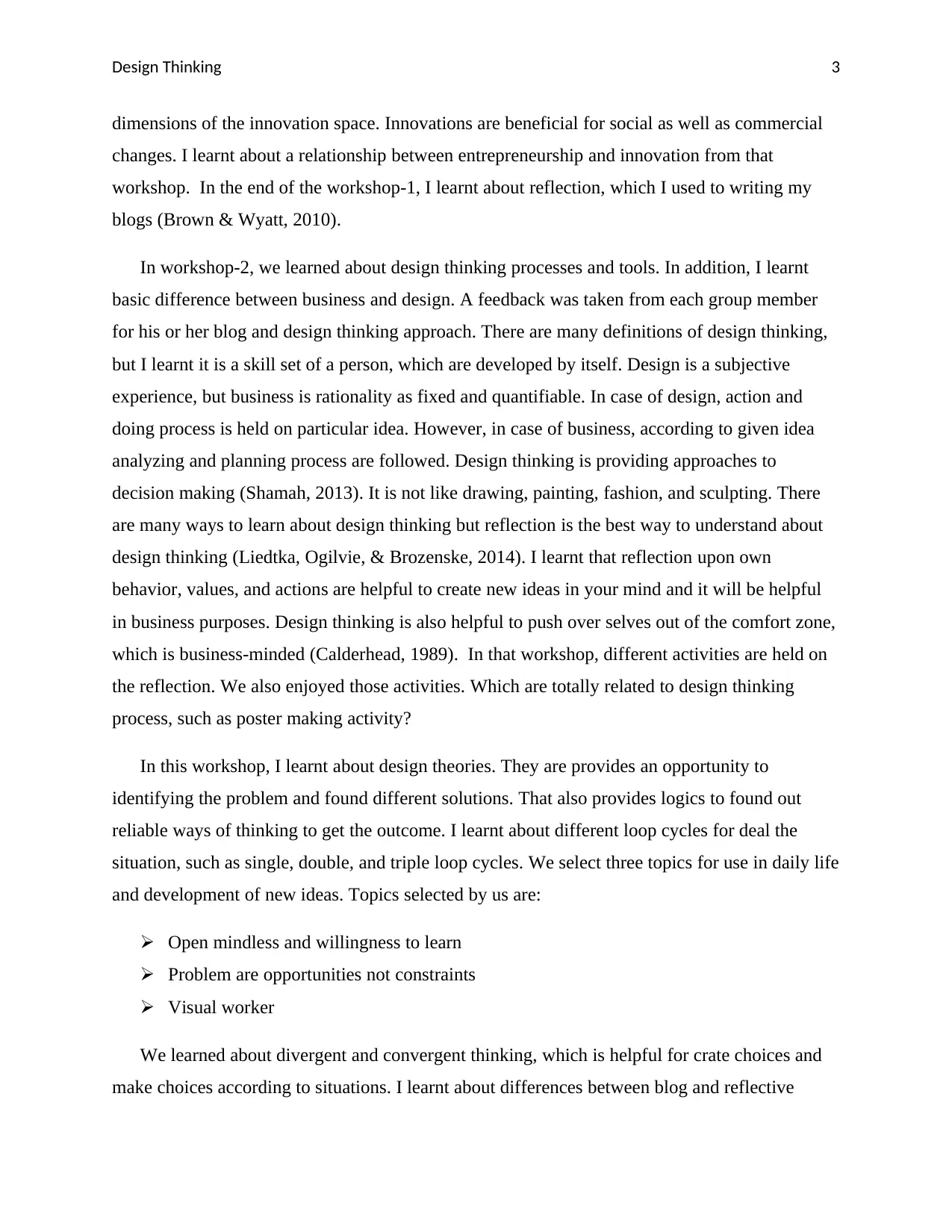
Design Thinking 3
dimensions of the innovation space. Innovations are beneficial for social as well as commercial
changes. I learnt about a relationship between entrepreneurship and innovation from that
workshop. In the end of the workshop-1, I learnt about reflection, which I used to writing my
blogs (Brown & Wyatt, 2010).
In workshop-2, we learned about design thinking processes and tools. In addition, I learnt
basic difference between business and design. A feedback was taken from each group member
for his or her blog and design thinking approach. There are many definitions of design thinking,
but I learnt it is a skill set of a person, which are developed by itself. Design is a subjective
experience, but business is rationality as fixed and quantifiable. In case of design, action and
doing process is held on particular idea. However, in case of business, according to given idea
analyzing and planning process are followed. Design thinking is providing approaches to
decision making (Shamah, 2013). It is not like drawing, painting, fashion, and sculpting. There
are many ways to learn about design thinking but reflection is the best way to understand about
design thinking (Liedtka, Ogilvie, & Brozenske, 2014). I learnt that reflection upon own
behavior, values, and actions are helpful to create new ideas in your mind and it will be helpful
in business purposes. Design thinking is also helpful to push over selves out of the comfort zone,
which is business-minded (Calderhead, 1989). In that workshop, different activities are held on
the reflection. We also enjoyed those activities. Which are totally related to design thinking
process, such as poster making activity?
In this workshop, I learnt about design theories. They are provides an opportunity to
identifying the problem and found different solutions. That also provides logics to found out
reliable ways of thinking to get the outcome. I learnt about different loop cycles for deal the
situation, such as single, double, and triple loop cycles. We select three topics for use in daily life
and development of new ideas. Topics selected by us are:
Open mindless and willingness to learn
Problem are opportunities not constraints
Visual worker
We learned about divergent and convergent thinking, which is helpful for crate choices and
make choices according to situations. I learnt about differences between blog and reflective
dimensions of the innovation space. Innovations are beneficial for social as well as commercial
changes. I learnt about a relationship between entrepreneurship and innovation from that
workshop. In the end of the workshop-1, I learnt about reflection, which I used to writing my
blogs (Brown & Wyatt, 2010).
In workshop-2, we learned about design thinking processes and tools. In addition, I learnt
basic difference between business and design. A feedback was taken from each group member
for his or her blog and design thinking approach. There are many definitions of design thinking,
but I learnt it is a skill set of a person, which are developed by itself. Design is a subjective
experience, but business is rationality as fixed and quantifiable. In case of design, action and
doing process is held on particular idea. However, in case of business, according to given idea
analyzing and planning process are followed. Design thinking is providing approaches to
decision making (Shamah, 2013). It is not like drawing, painting, fashion, and sculpting. There
are many ways to learn about design thinking but reflection is the best way to understand about
design thinking (Liedtka, Ogilvie, & Brozenske, 2014). I learnt that reflection upon own
behavior, values, and actions are helpful to create new ideas in your mind and it will be helpful
in business purposes. Design thinking is also helpful to push over selves out of the comfort zone,
which is business-minded (Calderhead, 1989). In that workshop, different activities are held on
the reflection. We also enjoyed those activities. Which are totally related to design thinking
process, such as poster making activity?
In this workshop, I learnt about design theories. They are provides an opportunity to
identifying the problem and found different solutions. That also provides logics to found out
reliable ways of thinking to get the outcome. I learnt about different loop cycles for deal the
situation, such as single, double, and triple loop cycles. We select three topics for use in daily life
and development of new ideas. Topics selected by us are:
Open mindless and willingness to learn
Problem are opportunities not constraints
Visual worker
We learned about divergent and convergent thinking, which is helpful for crate choices and
make choices according to situations. I learnt about differences between blog and reflective
Paraphrase This Document
Need a fresh take? Get an instant paraphrase of this document with our AI Paraphraser
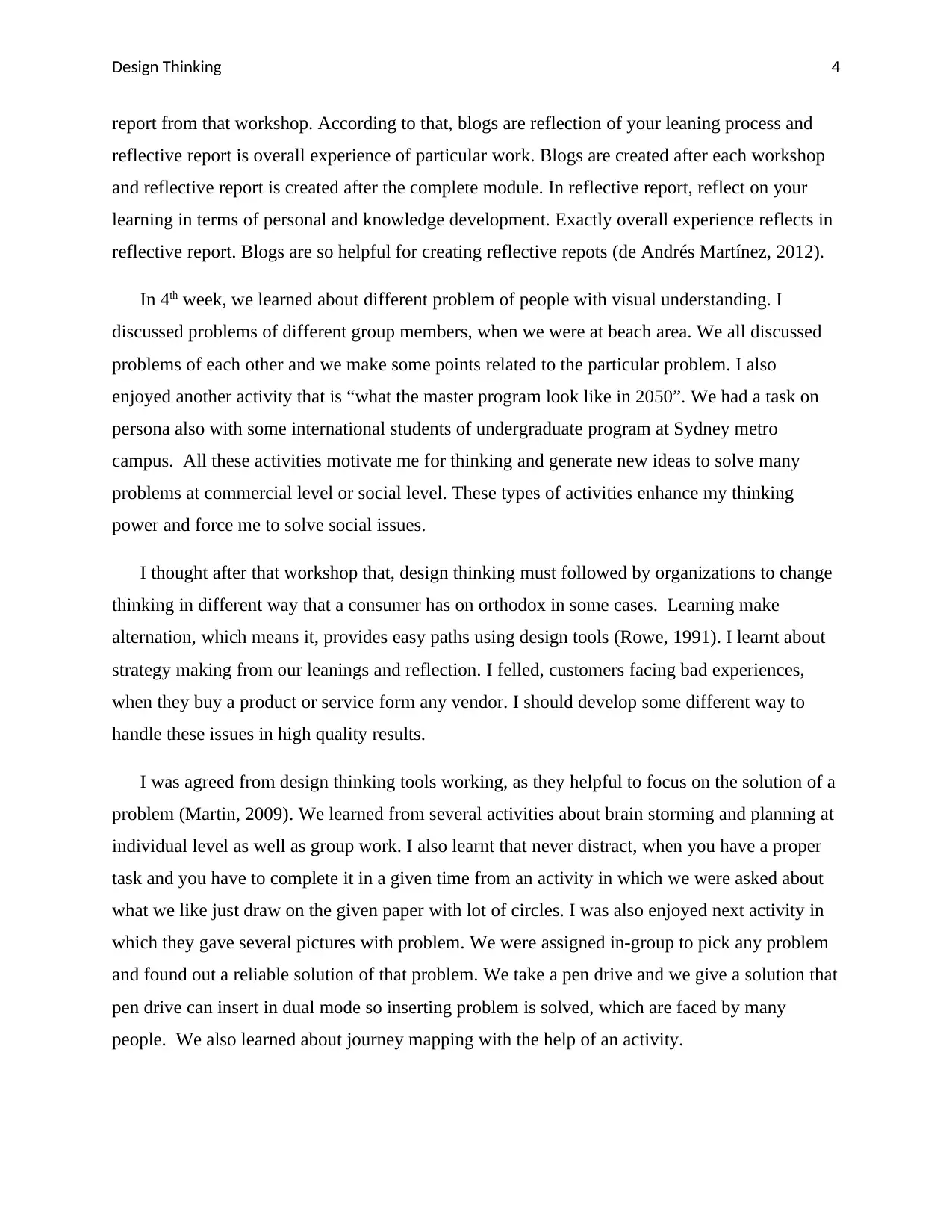
Design Thinking 4
report from that workshop. According to that, blogs are reflection of your leaning process and
reflective report is overall experience of particular work. Blogs are created after each workshop
and reflective report is created after the complete module. In reflective report, reflect on your
learning in terms of personal and knowledge development. Exactly overall experience reflects in
reflective report. Blogs are so helpful for creating reflective repots (de Andrés Martínez, 2012).
In 4th week, we learned about different problem of people with visual understanding. I
discussed problems of different group members, when we were at beach area. We all discussed
problems of each other and we make some points related to the particular problem. I also
enjoyed another activity that is “what the master program look like in 2050”. We had a task on
persona also with some international students of undergraduate program at Sydney metro
campus. All these activities motivate me for thinking and generate new ideas to solve many
problems at commercial level or social level. These types of activities enhance my thinking
power and force me to solve social issues.
I thought after that workshop that, design thinking must followed by organizations to change
thinking in different way that a consumer has on orthodox in some cases. Learning make
alternation, which means it, provides easy paths using design tools (Rowe, 1991). I learnt about
strategy making from our leanings and reflection. I felled, customers facing bad experiences,
when they buy a product or service form any vendor. I should develop some different way to
handle these issues in high quality results.
I was agreed from design thinking tools working, as they helpful to focus on the solution of a
problem (Martin, 2009). We learned from several activities about brain storming and planning at
individual level as well as group work. I also learnt that never distract, when you have a proper
task and you have to complete it in a given time from an activity in which we were asked about
what we like just draw on the given paper with lot of circles. I was also enjoyed next activity in
which they gave several pictures with problem. We were assigned in-group to pick any problem
and found out a reliable solution of that problem. We take a pen drive and we give a solution that
pen drive can insert in dual mode so inserting problem is solved, which are faced by many
people. We also learned about journey mapping with the help of an activity.
report from that workshop. According to that, blogs are reflection of your leaning process and
reflective report is overall experience of particular work. Blogs are created after each workshop
and reflective report is created after the complete module. In reflective report, reflect on your
learning in terms of personal and knowledge development. Exactly overall experience reflects in
reflective report. Blogs are so helpful for creating reflective repots (de Andrés Martínez, 2012).
In 4th week, we learned about different problem of people with visual understanding. I
discussed problems of different group members, when we were at beach area. We all discussed
problems of each other and we make some points related to the particular problem. I also
enjoyed another activity that is “what the master program look like in 2050”. We had a task on
persona also with some international students of undergraduate program at Sydney metro
campus. All these activities motivate me for thinking and generate new ideas to solve many
problems at commercial level or social level. These types of activities enhance my thinking
power and force me to solve social issues.
I thought after that workshop that, design thinking must followed by organizations to change
thinking in different way that a consumer has on orthodox in some cases. Learning make
alternation, which means it, provides easy paths using design tools (Rowe, 1991). I learnt about
strategy making from our leanings and reflection. I felled, customers facing bad experiences,
when they buy a product or service form any vendor. I should develop some different way to
handle these issues in high quality results.
I was agreed from design thinking tools working, as they helpful to focus on the solution of a
problem (Martin, 2009). We learned from several activities about brain storming and planning at
individual level as well as group work. I also learnt that never distract, when you have a proper
task and you have to complete it in a given time from an activity in which we were asked about
what we like just draw on the given paper with lot of circles. I was also enjoyed next activity in
which they gave several pictures with problem. We were assigned in-group to pick any problem
and found out a reliable solution of that problem. We take a pen drive and we give a solution that
pen drive can insert in dual mode so inserting problem is solved, which are faced by many
people. We also learned about journey mapping with the help of an activity.
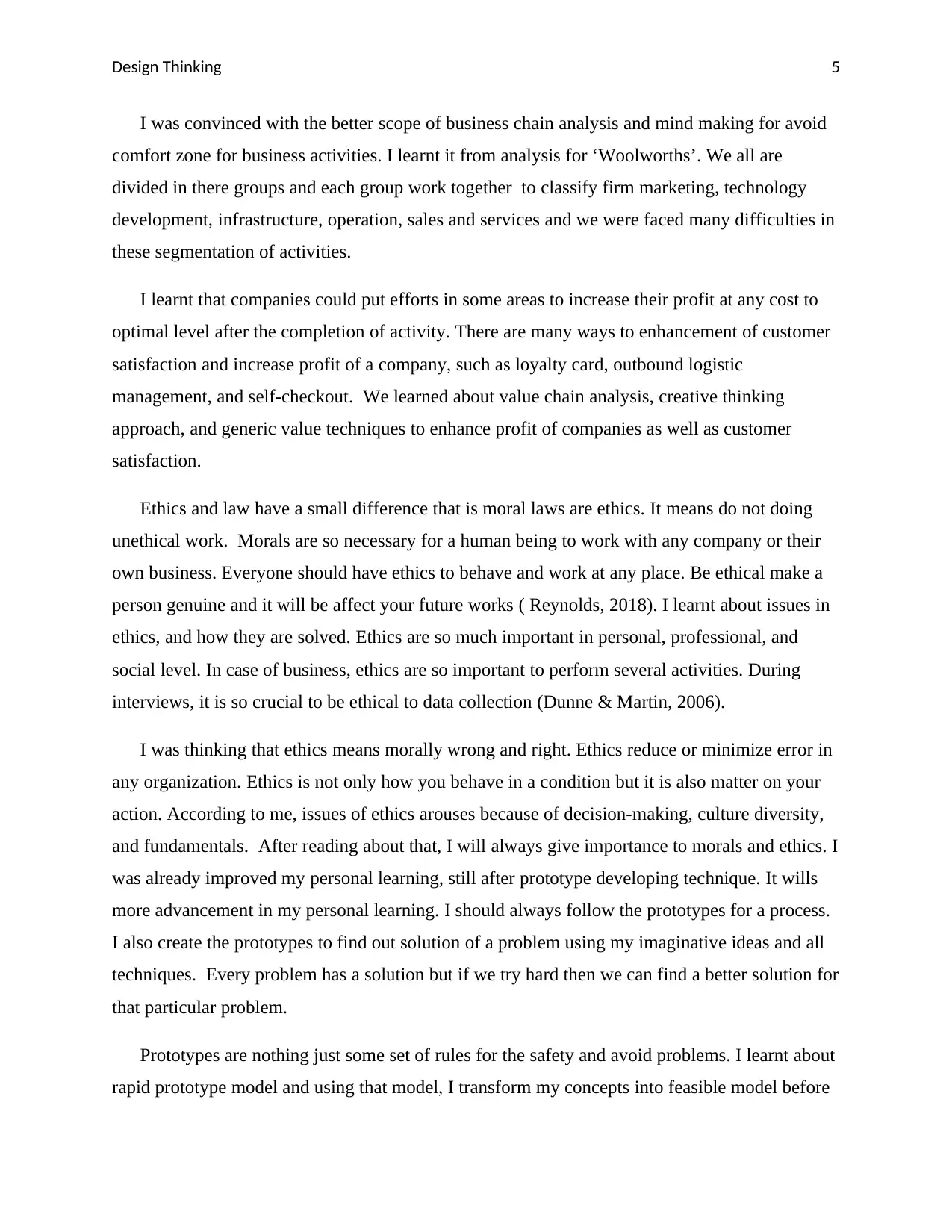
Design Thinking 5
I was convinced with the better scope of business chain analysis and mind making for avoid
comfort zone for business activities. I learnt it from analysis for ‘Woolworths’. We all are
divided in there groups and each group work together to classify firm marketing, technology
development, infrastructure, operation, sales and services and we were faced many difficulties in
these segmentation of activities.
I learnt that companies could put efforts in some areas to increase their profit at any cost to
optimal level after the completion of activity. There are many ways to enhancement of customer
satisfaction and increase profit of a company, such as loyalty card, outbound logistic
management, and self-checkout. We learned about value chain analysis, creative thinking
approach, and generic value techniques to enhance profit of companies as well as customer
satisfaction.
Ethics and law have a small difference that is moral laws are ethics. It means do not doing
unethical work. Morals are so necessary for a human being to work with any company or their
own business. Everyone should have ethics to behave and work at any place. Be ethical make a
person genuine and it will be affect your future works ( Reynolds, 2018). I learnt about issues in
ethics, and how they are solved. Ethics are so much important in personal, professional, and
social level. In case of business, ethics are so important to perform several activities. During
interviews, it is so crucial to be ethical to data collection (Dunne & Martin, 2006).
I was thinking that ethics means morally wrong and right. Ethics reduce or minimize error in
any organization. Ethics is not only how you behave in a condition but it is also matter on your
action. According to me, issues of ethics arouses because of decision-making, culture diversity,
and fundamentals. After reading about that, I will always give importance to morals and ethics. I
was already improved my personal learning, still after prototype developing technique. It wills
more advancement in my personal learning. I should always follow the prototypes for a process.
I also create the prototypes to find out solution of a problem using my imaginative ideas and all
techniques. Every problem has a solution but if we try hard then we can find a better solution for
that particular problem.
Prototypes are nothing just some set of rules for the safety and avoid problems. I learnt about
rapid prototype model and using that model, I transform my concepts into feasible model before
I was convinced with the better scope of business chain analysis and mind making for avoid
comfort zone for business activities. I learnt it from analysis for ‘Woolworths’. We all are
divided in there groups and each group work together to classify firm marketing, technology
development, infrastructure, operation, sales and services and we were faced many difficulties in
these segmentation of activities.
I learnt that companies could put efforts in some areas to increase their profit at any cost to
optimal level after the completion of activity. There are many ways to enhancement of customer
satisfaction and increase profit of a company, such as loyalty card, outbound logistic
management, and self-checkout. We learned about value chain analysis, creative thinking
approach, and generic value techniques to enhance profit of companies as well as customer
satisfaction.
Ethics and law have a small difference that is moral laws are ethics. It means do not doing
unethical work. Morals are so necessary for a human being to work with any company or their
own business. Everyone should have ethics to behave and work at any place. Be ethical make a
person genuine and it will be affect your future works ( Reynolds, 2018). I learnt about issues in
ethics, and how they are solved. Ethics are so much important in personal, professional, and
social level. In case of business, ethics are so important to perform several activities. During
interviews, it is so crucial to be ethical to data collection (Dunne & Martin, 2006).
I was thinking that ethics means morally wrong and right. Ethics reduce or minimize error in
any organization. Ethics is not only how you behave in a condition but it is also matter on your
action. According to me, issues of ethics arouses because of decision-making, culture diversity,
and fundamentals. After reading about that, I will always give importance to morals and ethics. I
was already improved my personal learning, still after prototype developing technique. It wills
more advancement in my personal learning. I should always follow the prototypes for a process.
I also create the prototypes to find out solution of a problem using my imaginative ideas and all
techniques. Every problem has a solution but if we try hard then we can find a better solution for
that particular problem.
Prototypes are nothing just some set of rules for the safety and avoid problems. I learnt about
rapid prototype model and using that model, I transform my concepts into feasible model before
⊘ This is a preview!⊘
Do you want full access?
Subscribe today to unlock all pages.

Trusted by 1+ million students worldwide
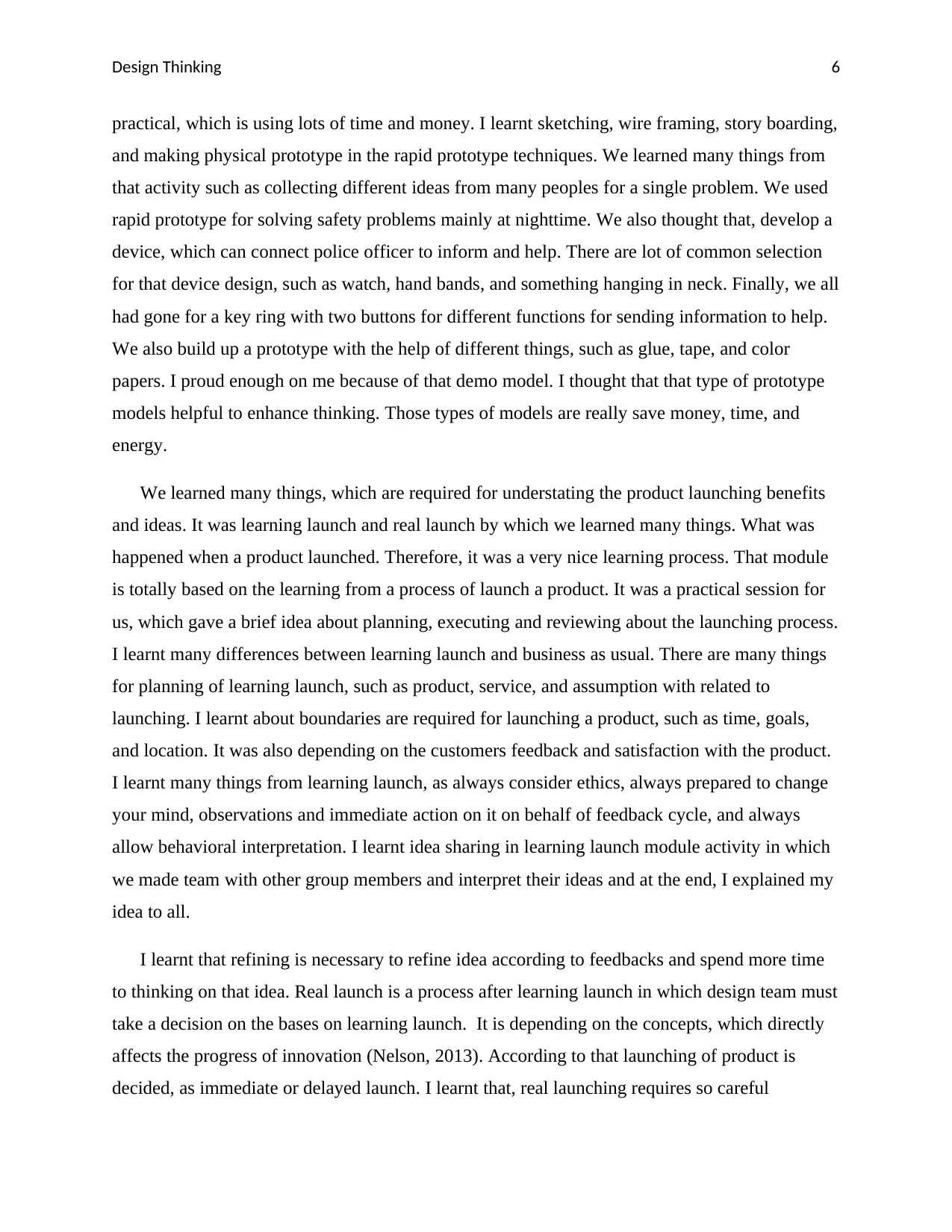
Design Thinking 6
practical, which is using lots of time and money. I learnt sketching, wire framing, story boarding,
and making physical prototype in the rapid prototype techniques. We learned many things from
that activity such as collecting different ideas from many peoples for a single problem. We used
rapid prototype for solving safety problems mainly at nighttime. We also thought that, develop a
device, which can connect police officer to inform and help. There are lot of common selection
for that device design, such as watch, hand bands, and something hanging in neck. Finally, we all
had gone for a key ring with two buttons for different functions for sending information to help.
We also build up a prototype with the help of different things, such as glue, tape, and color
papers. I proud enough on me because of that demo model. I thought that that type of prototype
models helpful to enhance thinking. Those types of models are really save money, time, and
energy.
We learned many things, which are required for understating the product launching benefits
and ideas. It was learning launch and real launch by which we learned many things. What was
happened when a product launched. Therefore, it was a very nice learning process. That module
is totally based on the learning from a process of launch a product. It was a practical session for
us, which gave a brief idea about planning, executing and reviewing about the launching process.
I learnt many differences between learning launch and business as usual. There are many things
for planning of learning launch, such as product, service, and assumption with related to
launching. I learnt about boundaries are required for launching a product, such as time, goals,
and location. It was also depending on the customers feedback and satisfaction with the product.
I learnt many things from learning launch, as always consider ethics, always prepared to change
your mind, observations and immediate action on it on behalf of feedback cycle, and always
allow behavioral interpretation. I learnt idea sharing in learning launch module activity in which
we made team with other group members and interpret their ideas and at the end, I explained my
idea to all.
I learnt that refining is necessary to refine idea according to feedbacks and spend more time
to thinking on that idea. Real launch is a process after learning launch in which design team must
take a decision on the bases on learning launch. It is depending on the concepts, which directly
affects the progress of innovation (Nelson, 2013). According to that launching of product is
decided, as immediate or delayed launch. I learnt that, real launching requires so careful
practical, which is using lots of time and money. I learnt sketching, wire framing, story boarding,
and making physical prototype in the rapid prototype techniques. We learned many things from
that activity such as collecting different ideas from many peoples for a single problem. We used
rapid prototype for solving safety problems mainly at nighttime. We also thought that, develop a
device, which can connect police officer to inform and help. There are lot of common selection
for that device design, such as watch, hand bands, and something hanging in neck. Finally, we all
had gone for a key ring with two buttons for different functions for sending information to help.
We also build up a prototype with the help of different things, such as glue, tape, and color
papers. I proud enough on me because of that demo model. I thought that that type of prototype
models helpful to enhance thinking. Those types of models are really save money, time, and
energy.
We learned many things, which are required for understating the product launching benefits
and ideas. It was learning launch and real launch by which we learned many things. What was
happened when a product launched. Therefore, it was a very nice learning process. That module
is totally based on the learning from a process of launch a product. It was a practical session for
us, which gave a brief idea about planning, executing and reviewing about the launching process.
I learnt many differences between learning launch and business as usual. There are many things
for planning of learning launch, such as product, service, and assumption with related to
launching. I learnt about boundaries are required for launching a product, such as time, goals,
and location. It was also depending on the customers feedback and satisfaction with the product.
I learnt many things from learning launch, as always consider ethics, always prepared to change
your mind, observations and immediate action on it on behalf of feedback cycle, and always
allow behavioral interpretation. I learnt idea sharing in learning launch module activity in which
we made team with other group members and interpret their ideas and at the end, I explained my
idea to all.
I learnt that refining is necessary to refine idea according to feedbacks and spend more time
to thinking on that idea. Real launch is a process after learning launch in which design team must
take a decision on the bases on learning launch. It is depending on the concepts, which directly
affects the progress of innovation (Nelson, 2013). According to that launching of product is
decided, as immediate or delayed launch. I learnt that, real launching requires so careful
Paraphrase This Document
Need a fresh take? Get an instant paraphrase of this document with our AI Paraphraser
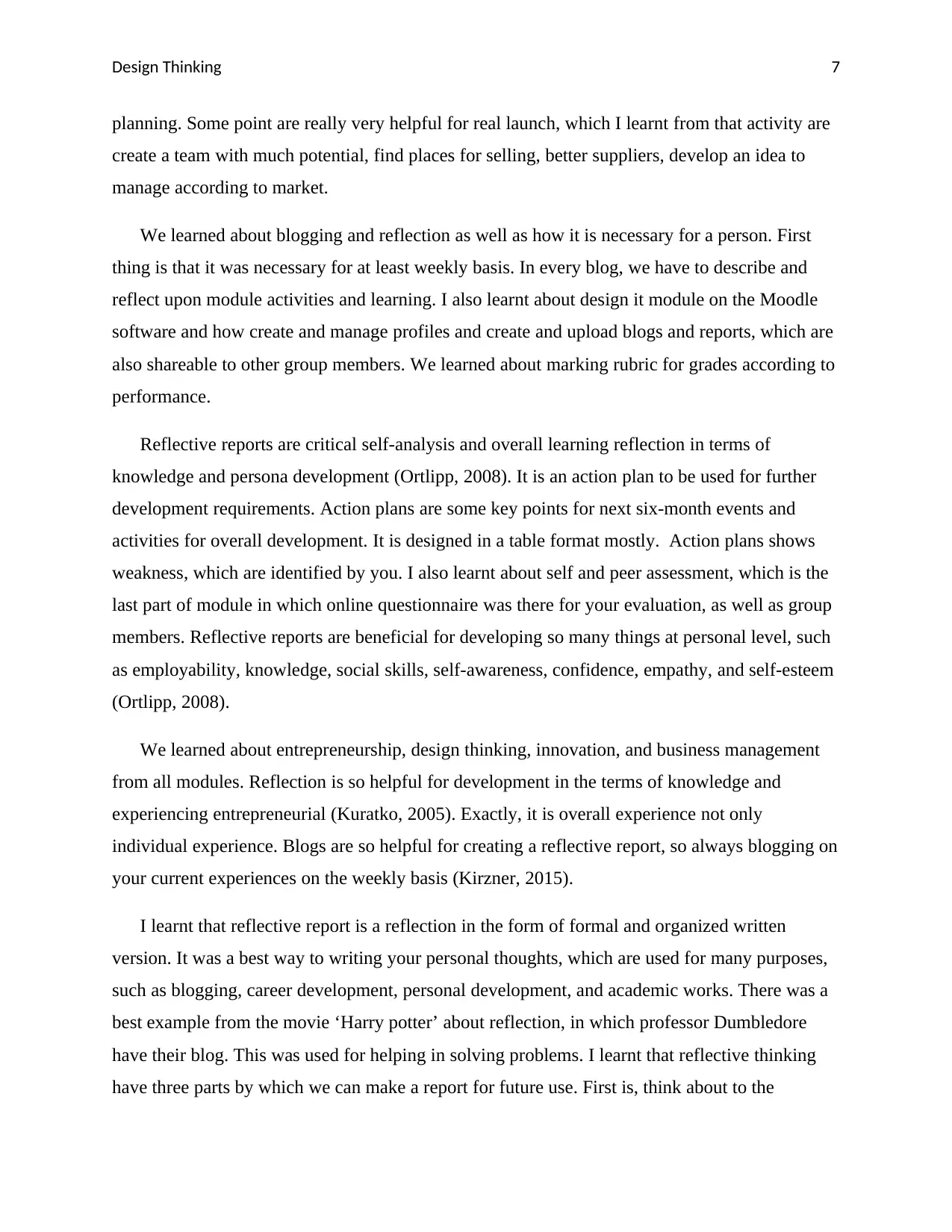
Design Thinking 7
planning. Some point are really very helpful for real launch, which I learnt from that activity are
create a team with much potential, find places for selling, better suppliers, develop an idea to
manage according to market.
We learned about blogging and reflection as well as how it is necessary for a person. First
thing is that it was necessary for at least weekly basis. In every blog, we have to describe and
reflect upon module activities and learning. I also learnt about design it module on the Moodle
software and how create and manage profiles and create and upload blogs and reports, which are
also shareable to other group members. We learned about marking rubric for grades according to
performance.
Reflective reports are critical self-analysis and overall learning reflection in terms of
knowledge and persona development (Ortlipp, 2008). It is an action plan to be used for further
development requirements. Action plans are some key points for next six-month events and
activities for overall development. It is designed in a table format mostly. Action plans shows
weakness, which are identified by you. I also learnt about self and peer assessment, which is the
last part of module in which online questionnaire was there for your evaluation, as well as group
members. Reflective reports are beneficial for developing so many things at personal level, such
as employability, knowledge, social skills, self-awareness, confidence, empathy, and self-esteem
(Ortlipp, 2008).
We learned about entrepreneurship, design thinking, innovation, and business management
from all modules. Reflection is so helpful for development in the terms of knowledge and
experiencing entrepreneurial (Kuratko, 2005). Exactly, it is overall experience not only
individual experience. Blogs are so helpful for creating a reflective report, so always blogging on
your current experiences on the weekly basis (Kirzner, 2015).
I learnt that reflective report is a reflection in the form of formal and organized written
version. It was a best way to writing your personal thoughts, which are used for many purposes,
such as blogging, career development, personal development, and academic works. There was a
best example from the movie ‘Harry potter’ about reflection, in which professor Dumbledore
have their blog. This was used for helping in solving problems. I learnt that reflective thinking
have three parts by which we can make a report for future use. First is, think about to the
planning. Some point are really very helpful for real launch, which I learnt from that activity are
create a team with much potential, find places for selling, better suppliers, develop an idea to
manage according to market.
We learned about blogging and reflection as well as how it is necessary for a person. First
thing is that it was necessary for at least weekly basis. In every blog, we have to describe and
reflect upon module activities and learning. I also learnt about design it module on the Moodle
software and how create and manage profiles and create and upload blogs and reports, which are
also shareable to other group members. We learned about marking rubric for grades according to
performance.
Reflective reports are critical self-analysis and overall learning reflection in terms of
knowledge and persona development (Ortlipp, 2008). It is an action plan to be used for further
development requirements. Action plans are some key points for next six-month events and
activities for overall development. It is designed in a table format mostly. Action plans shows
weakness, which are identified by you. I also learnt about self and peer assessment, which is the
last part of module in which online questionnaire was there for your evaluation, as well as group
members. Reflective reports are beneficial for developing so many things at personal level, such
as employability, knowledge, social skills, self-awareness, confidence, empathy, and self-esteem
(Ortlipp, 2008).
We learned about entrepreneurship, design thinking, innovation, and business management
from all modules. Reflection is so helpful for development in the terms of knowledge and
experiencing entrepreneurial (Kuratko, 2005). Exactly, it is overall experience not only
individual experience. Blogs are so helpful for creating a reflective report, so always blogging on
your current experiences on the weekly basis (Kirzner, 2015).
I learnt that reflective report is a reflection in the form of formal and organized written
version. It was a best way to writing your personal thoughts, which are used for many purposes,
such as blogging, career development, personal development, and academic works. There was a
best example from the movie ‘Harry potter’ about reflection, in which professor Dumbledore
have their blog. This was used for helping in solving problems. I learnt that reflective thinking
have three parts by which we can make a report for future use. First is, think about to the
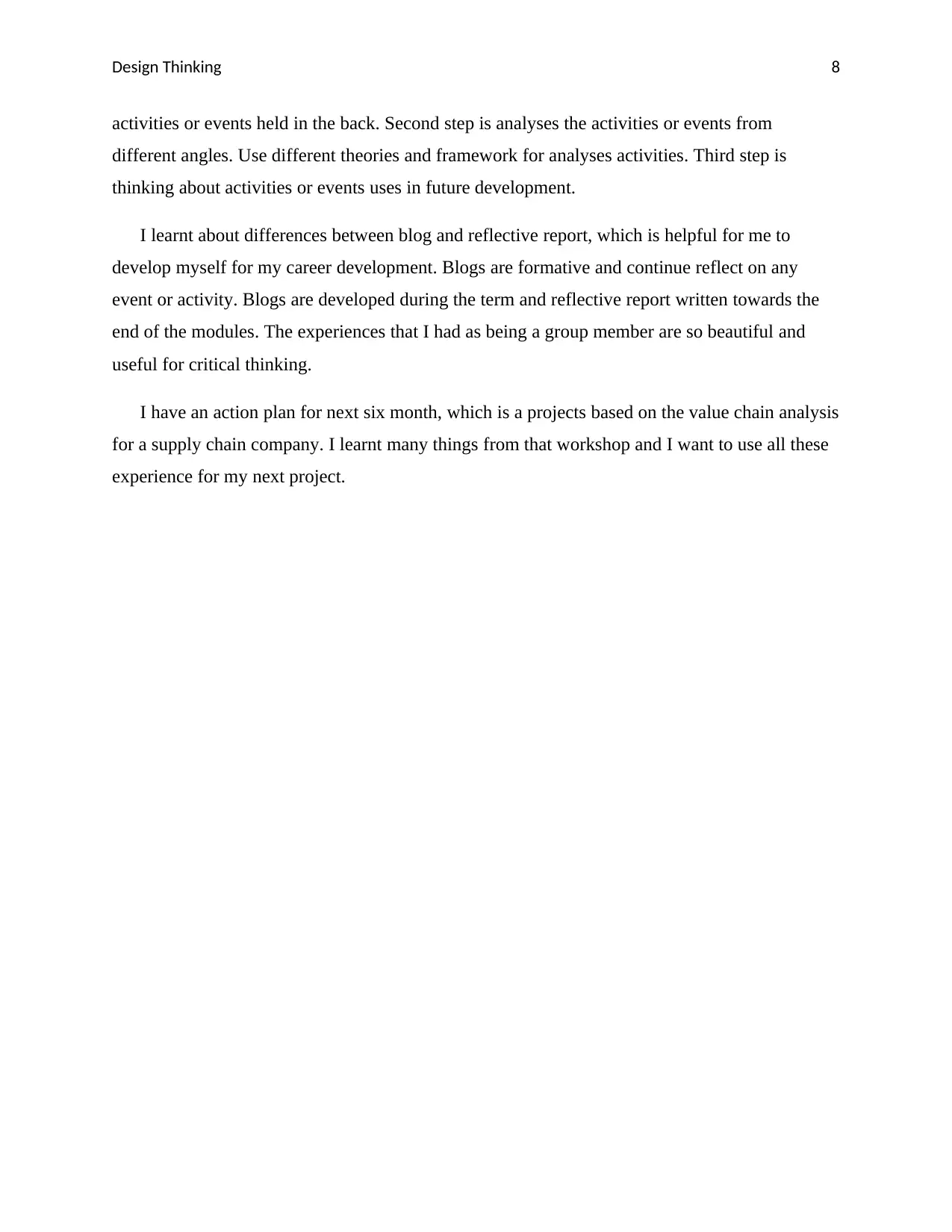
Design Thinking 8
activities or events held in the back. Second step is analyses the activities or events from
different angles. Use different theories and framework for analyses activities. Third step is
thinking about activities or events uses in future development.
I learnt about differences between blog and reflective report, which is helpful for me to
develop myself for my career development. Blogs are formative and continue reflect on any
event or activity. Blogs are developed during the term and reflective report written towards the
end of the modules. The experiences that I had as being a group member are so beautiful and
useful for critical thinking.
I have an action plan for next six month, which is a projects based on the value chain analysis
for a supply chain company. I learnt many things from that workshop and I want to use all these
experience for my next project.
activities or events held in the back. Second step is analyses the activities or events from
different angles. Use different theories and framework for analyses activities. Third step is
thinking about activities or events uses in future development.
I learnt about differences between blog and reflective report, which is helpful for me to
develop myself for my career development. Blogs are formative and continue reflect on any
event or activity. Blogs are developed during the term and reflective report written towards the
end of the modules. The experiences that I had as being a group member are so beautiful and
useful for critical thinking.
I have an action plan for next six month, which is a projects based on the value chain analysis
for a supply chain company. I learnt many things from that workshop and I want to use all these
experience for my next project.
⊘ This is a preview!⊘
Do you want full access?
Subscribe today to unlock all pages.

Trusted by 1+ million students worldwide
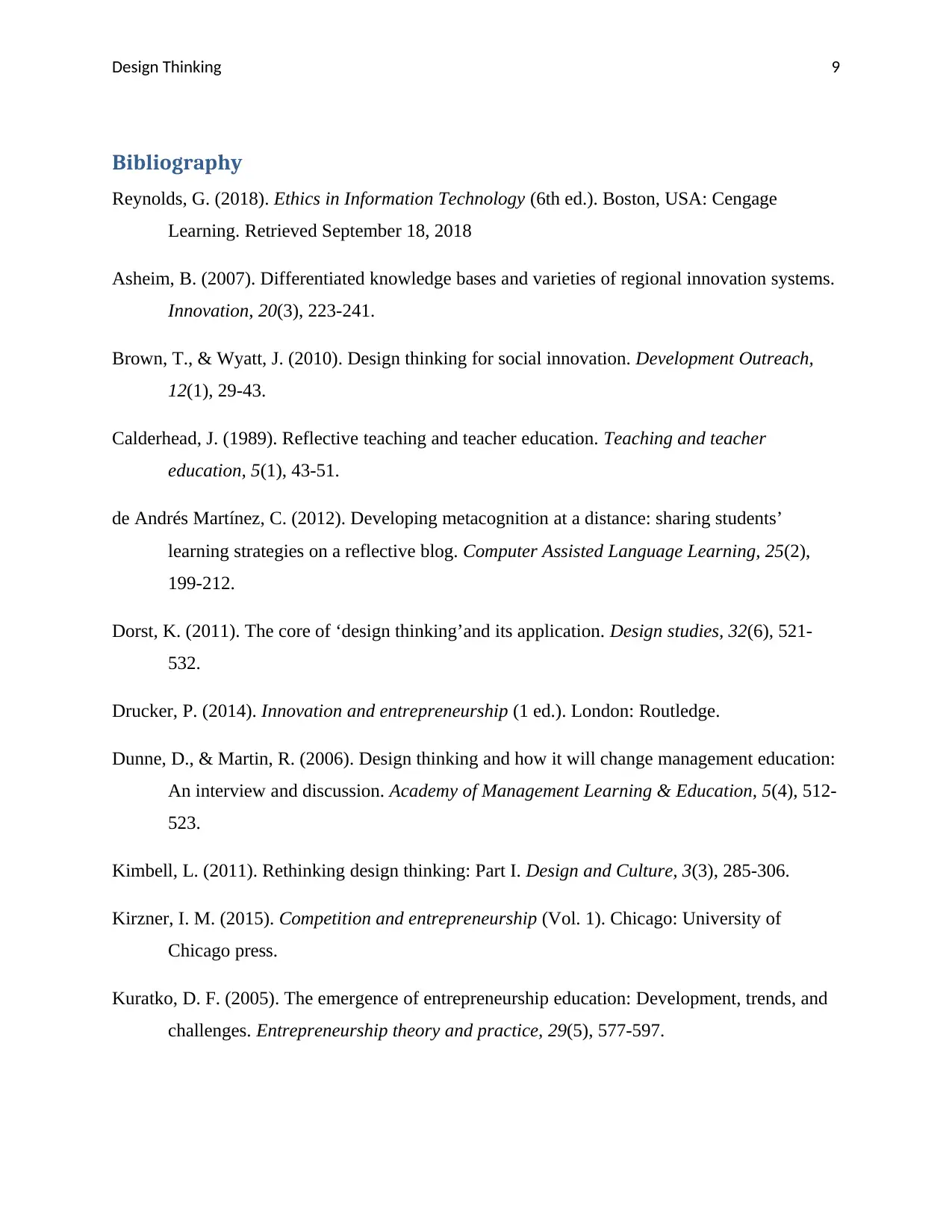
Design Thinking 9
Bibliography
Reynolds, G. (2018). Ethics in Information Technology (6th ed.). Boston, USA: Cengage
Learning. Retrieved September 18, 2018
Asheim, B. (2007). Differentiated knowledge bases and varieties of regional innovation systems.
Innovation, 20(3), 223-241.
Brown, T., & Wyatt, J. (2010). Design thinking for social innovation. Development Outreach,
12(1), 29-43.
Calderhead, J. (1989). Reflective teaching and teacher education. Teaching and teacher
education, 5(1), 43-51.
de Andrés Martínez, C. (2012). Developing metacognition at a distance: sharing students’
learning strategies on a reflective blog. Computer Assisted Language Learning, 25(2),
199-212.
Dorst, K. (2011). The core of ‘design thinking’and its application. Design studies, 32(6), 521-
532.
Drucker, P. (2014). Innovation and entrepreneurship (1 ed.). London: Routledge.
Dunne, D., & Martin, R. (2006). Design thinking and how it will change management education:
An interview and discussion. Academy of Management Learning & Education, 5(4), 512-
523.
Kimbell, L. (2011). Rethinking design thinking: Part I. Design and Culture, 3(3), 285-306.
Kirzner, I. M. (2015). Competition and entrepreneurship (Vol. 1). Chicago: University of
Chicago press.
Kuratko, D. F. (2005). The emergence of entrepreneurship education: Development, trends, and
challenges. Entrepreneurship theory and practice, 29(5), 577-597.
Bibliography
Reynolds, G. (2018). Ethics in Information Technology (6th ed.). Boston, USA: Cengage
Learning. Retrieved September 18, 2018
Asheim, B. (2007). Differentiated knowledge bases and varieties of regional innovation systems.
Innovation, 20(3), 223-241.
Brown, T., & Wyatt, J. (2010). Design thinking for social innovation. Development Outreach,
12(1), 29-43.
Calderhead, J. (1989). Reflective teaching and teacher education. Teaching and teacher
education, 5(1), 43-51.
de Andrés Martínez, C. (2012). Developing metacognition at a distance: sharing students’
learning strategies on a reflective blog. Computer Assisted Language Learning, 25(2),
199-212.
Dorst, K. (2011). The core of ‘design thinking’and its application. Design studies, 32(6), 521-
532.
Drucker, P. (2014). Innovation and entrepreneurship (1 ed.). London: Routledge.
Dunne, D., & Martin, R. (2006). Design thinking and how it will change management education:
An interview and discussion. Academy of Management Learning & Education, 5(4), 512-
523.
Kimbell, L. (2011). Rethinking design thinking: Part I. Design and Culture, 3(3), 285-306.
Kirzner, I. M. (2015). Competition and entrepreneurship (Vol. 1). Chicago: University of
Chicago press.
Kuratko, D. F. (2005). The emergence of entrepreneurship education: Development, trends, and
challenges. Entrepreneurship theory and practice, 29(5), 577-597.
Paraphrase This Document
Need a fresh take? Get an instant paraphrase of this document with our AI Paraphraser
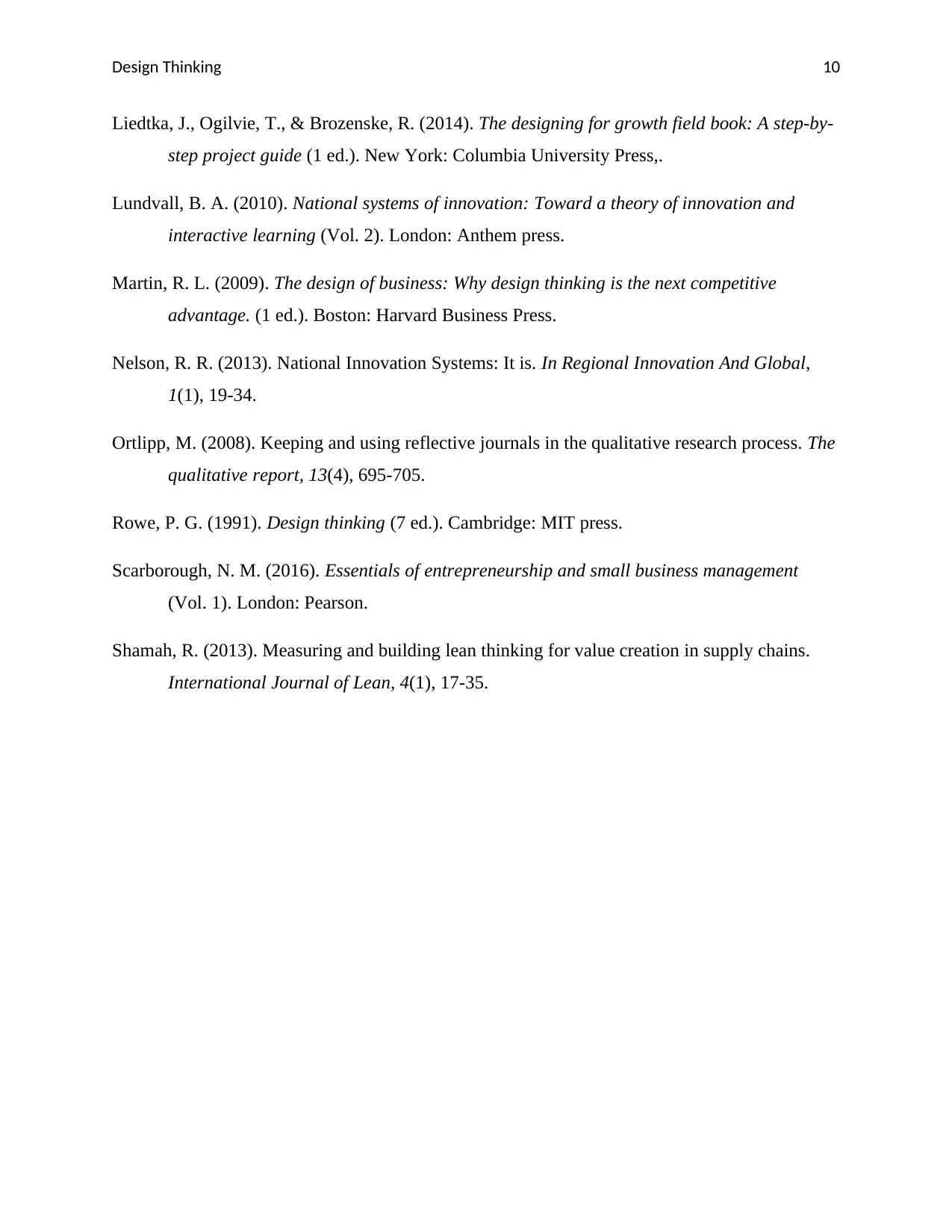
Design Thinking 10
Liedtka, J., Ogilvie, T., & Brozenske, R. (2014). The designing for growth field book: A step-by-
step project guide (1 ed.). New York: Columbia University Press,.
Lundvall, B. A. (2010). National systems of innovation: Toward a theory of innovation and
interactive learning (Vol. 2). London: Anthem press.
Martin, R. L. (2009). The design of business: Why design thinking is the next competitive
advantage. (1 ed.). Boston: Harvard Business Press.
Nelson, R. R. (2013). National Innovation Systems: It is. In Regional Innovation And Global,
1(1), 19-34.
Ortlipp, M. (2008). Keeping and using reflective journals in the qualitative research process. The
qualitative report, 13(4), 695-705.
Rowe, P. G. (1991). Design thinking (7 ed.). Cambridge: MIT press.
Scarborough, N. M. (2016). Essentials of entrepreneurship and small business management
(Vol. 1). London: Pearson.
Shamah, R. (2013). Measuring and building lean thinking for value creation in supply chains.
International Journal of Lean, 4(1), 17-35.
Liedtka, J., Ogilvie, T., & Brozenske, R. (2014). The designing for growth field book: A step-by-
step project guide (1 ed.). New York: Columbia University Press,.
Lundvall, B. A. (2010). National systems of innovation: Toward a theory of innovation and
interactive learning (Vol. 2). London: Anthem press.
Martin, R. L. (2009). The design of business: Why design thinking is the next competitive
advantage. (1 ed.). Boston: Harvard Business Press.
Nelson, R. R. (2013). National Innovation Systems: It is. In Regional Innovation And Global,
1(1), 19-34.
Ortlipp, M. (2008). Keeping and using reflective journals in the qualitative research process. The
qualitative report, 13(4), 695-705.
Rowe, P. G. (1991). Design thinking (7 ed.). Cambridge: MIT press.
Scarborough, N. M. (2016). Essentials of entrepreneurship and small business management
(Vol. 1). London: Pearson.
Shamah, R. (2013). Measuring and building lean thinking for value creation in supply chains.
International Journal of Lean, 4(1), 17-35.
1 out of 11
Related Documents
Your All-in-One AI-Powered Toolkit for Academic Success.
+13062052269
info@desklib.com
Available 24*7 on WhatsApp / Email
![[object Object]](/_next/static/media/star-bottom.7253800d.svg)
Unlock your academic potential
Copyright © 2020–2025 A2Z Services. All Rights Reserved. Developed and managed by ZUCOL.



